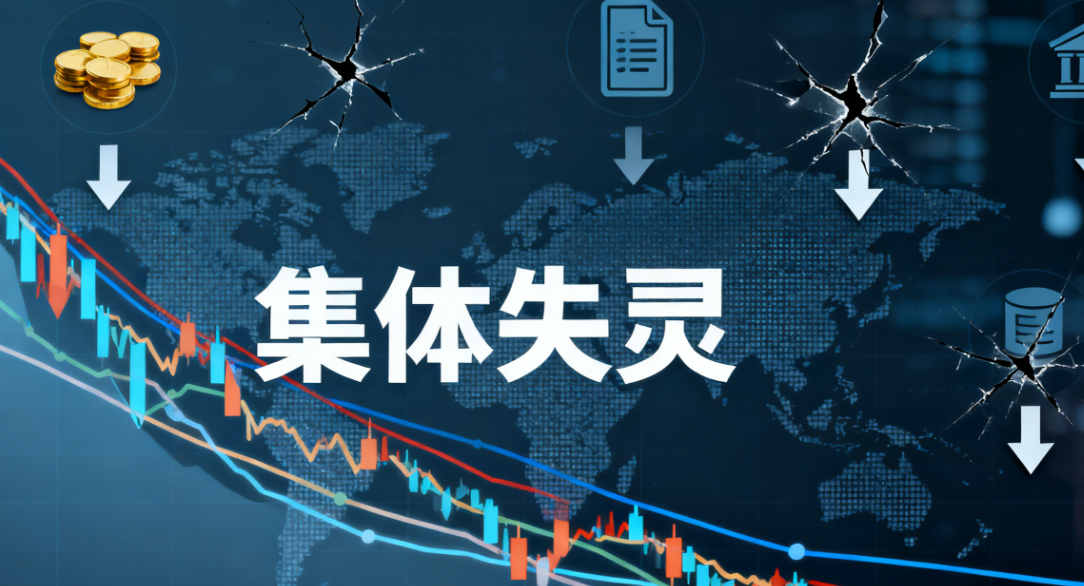Author: DeFi Warhol
Translation: ShenChao TechFlow
Cryptocurrency airdrops are often seen as "free money," but experienced "farmers" know that not every airdrop is worth the gas fees and effort. Over the past 5 to 7 years, I have participated in dozens of airdrops, some of which yielded six-figure returns, while others resulted in nothing.
The key lies in careful evaluation. In this report, I will attempt to establish a framework for assessing airdrop potential.
I propose an objective assessment method to determine whether a particular airdrop opportunity is worth participating in or should be skipped altogether. I will combine real-world cases (from the legendary Uniswap airdrop to recent Layer 2 airdrops) and use quantitative benchmarks to help professional crypto users and even venture capital firms identify high-return, low-risk airdrop opportunities.
Key Factors for Airdrop Evaluation
Evaluating the potential of an airdrop is not based on guesswork or blindly following trends, but rather a structured analytical process. We can break it down into several key criteria, each focusing on an important aspect of risk or return:
Fundamentals and Narrative of the Protocol
Token Distribution and Tokenomics
Eligibility Criteria and Anti-Sybil Attack Mechanisms
Investment, Costs, and Risk-Reward Ratio
Market Environment and Timing
Liquidity and Exit Strategies
Next, we will delve into each factor, including what questions to ask and why these questions are important.
Protocol Fundamentals and Narrative
Before engaging with testnets or transferring funds across chains, it is essential to evaluate the project itself. Airdrops are not "magic" that appears out of nowhere; their value derives from the success of the underlying protocol.
Does the project solve a real problem or merely chase trends?
A strong use case or innovative technology (such as a new scaling solution or unique DeFi primitives) indicates that the token may retain value even after initial hype fades. For example, Arbitrum, as Ethereum's leading Layer 2 solution, achieved real user adoption even before its token was issued, instilling confidence in participants regarding the potential value of its airdrop. In contrast, many imitation projects without unique value saw their prices plummet as farmers sold off tokens after issuance.
Is there an appealing narrative or market trend?
One of the driving forces in the crypto market is narrative. During the 2023-2024 period, themes like modular blockchains, restaking, and ZK-rollups attracted significant investor attention. A project that aligns with a hot narrative (such as a modular data network like Celestia) may see a surge in token demand due to the narrative's popularity. However, narratives can also quickly lose appeal (as they often do). I prefer to choose projects that have technical substance backing them.
Are users and developers genuinely active?
Checking on-chain data and community channels is crucial. High testnet activity, a vibrant Discord community, and weekly developer updates are all positive signals. If the project's usage is not entirely speculative, that's even better. For instance, Blur (an NFT marketplace) demonstrated explosive growth and real trading volume by combining airdrops with gamification mechanisms, indicating that its appeal is organic rather than solely reliant on the short-term actions of "speculative farmers."
A solid fundamental story and a group of actively engaged users are fundamental to a project's success. If the protocol itself is not strong enough, no matter how cleverly designed the airdrop is, it cannot sustain the token's value in the long run.
I have personally learned this lesson the hard way. In 2022, I spent months participating in several Layer 1 (L1) testnets, but these projects never attracted real users. Even when these tokens eventually launched, there was no market demand, and prices quickly plummeted by over 90%.
In short, if I have no interest in a project beyond the airdrop, I will think twice.
Token Distribution and Tokenomics
Token design is another critical aspect. This includes the total amount of tokens allocated for the airdrop, the rules for distribution and unlocking, and the implied valuation. Key points I focus on include:
User Allocation (percentage of total supply)
Value Capture Ability
Unlocking and Lock-up Mechanisms
Fully Diluted Valuation (FDV)
Pre-listing Market Dynamics
Fairness of Distribution
User Allocation
How big of a slice of the pie can airdrop users get?
The proportion of the airdrop allocated to users is crucial. Airdrops that provide meaningful shares to users often cultivate stronger communities and can even support token prices. From experience, airdrops that allocate more than 10% of the total supply typically perform better, with higher user retention rates, while those below 5% are often quickly sold off. For example, Uniswap's famous airdrop in 2020 allocated 15% of the total $UNI supply to users, which was worth about $6.4 billion at its peak. This not only helped Uniswap build a loyal governance community but also provided strong support for its token value.

In contrast, some airdrop projects in 2024 had very small user allocation ratios, with most tokens held by insiders. Users typically sell off their small shares quickly, leading to prices that can never recover. Celestia allocated about 7.4% of $TIA to its "Genesis Drop" (for testnet participants and early adopters), while Arbitrum's airdrop in March 2023 allocated about 11.6% of the supply. Both of these allocation ratios are large enough to give users a sense of participation. If only a tiny portion of the supply is allocated to the community, I would view it as a warning sign that the token may face sell-off risks.
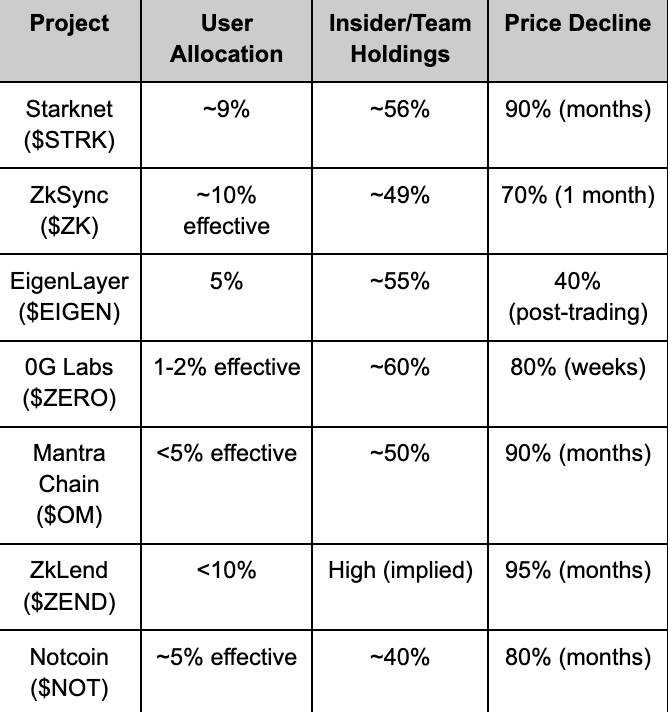
Low user allocation and insider-dominated crypto airdrops in 2024
Value Capture
What role does the token play? How does it capture value?
Not all tokens benefit from the success of the protocol, which is a fatal disconnect in many airdrop projects.
Some tokens are solely for governance, such as $UNI or $DYDX. If a decentralized autonomous organization (DAO) can manage substantial cash flows or system parameters, then governance functions may create defensible long-term value. However, in low-fee or passive protocols, this governance function often becomes superficial influence. When protocol upgrades are unrelated to token holders, the market quickly discounts tokens that are "only for governance."
Other tokens, such as $HYPE or $GMX, link token value to revenue, whether through staking, buybacks, or native earnings (real or synthetic). These tokens provide "farmers" with options: earn airdrop rewards and hold cash flow. I prefer designs where airdrop tokens have an active economic role, not just governance symbols, but tokens that can participate in fee sharing, inflationary rewards, or protocol throughput.
Lock-up and Unlock Mechanisms
Are the airdrop tokens immediately transferable, or are they locked or released in stages?
For "farmers," immediately transferable tokens are usually better (I can sell right away and lock in profits). If tokens are non-transferable or time-locked, you are effectively forced to become a "long-term holder," and I often joke that this is merely the result of "short-term speculation failure."
A case to be wary of is the 2024 EigenLayer $EIGEN airdrop. Users spent a year mining points, but when the tokens launched, they were not immediately transferable, angering those farmers who could not cash out.
We typically avoid airdrops that require long lock-up periods or use veToken models unless I have extremely high confidence in the project's long-term value. My strategy is to maintain optionality; I want to be able to choose to sell early. A memorable saying is: "No protocol can be 100% safe, so no airdrop should assume I will hold 100% forever."
Fully Diluted Valuation (FDV)
Estimate the FDV (total supply * expected market price) at the time of token launch.
An excessively high FDV can ruin a token's price; it is essential to understand that airdrops do not create "magic" that defies basic valuation logic. In 2024, many airdrop projects launched with extremely high FDVs, but their prices plummeted by 50%-80% within two weeks.
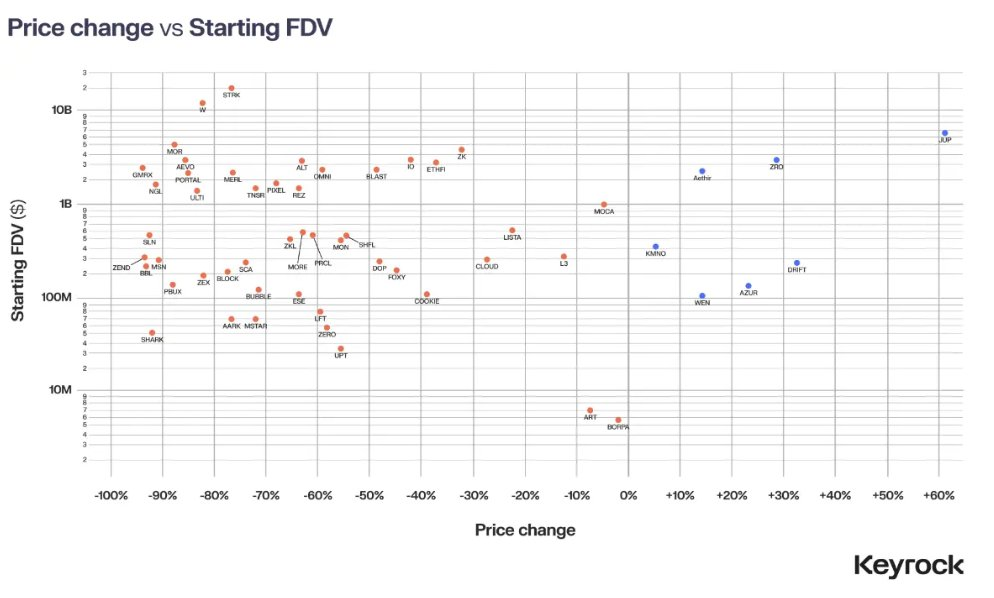
A study of 62 airdrop projects found that 88% of tokens experienced price declines within 15 days, often due to unreasonable initial pricing.
I look for a certain margin of safety: if similar projects are valued at $500 million, and this project has an implied valuation of $5 billion, caution is warranted. Conversely, if the project is of high quality and has a moderate initial market cap, this is usually a bullish signal.
Additionally, liquidity must be considered: will the token be listed on major exchanges, or does it have deep liquidity on decentralized exchanges (DEX)? Without sufficient liquidity to absorb selling pressure, even excellent projects can experience significant sell-offs. Among the few airdrop projects in 2024 that managed to maintain value after the first month, deep liquidity and reasonable FDV were common characteristics.
Pre-TGE Market and Early Valuation Signals
A noteworthy new dynamic is the rise of pre-TGE token markets. In these markets, projects associated with large airdrops begin trading on perpetual DEX or over-the-counter (OTC) platforms before the tokens officially launch.
These early markets often reflect aggressive expectations, sometimes implying billions of dollars in FDV based solely on hype. For "farmers," these signals are crucial: high pre-TGE pricing can enhance the credibility of the narrative and even motivate participation in mining. However, this also amplifies risks: if the fundamentals cannot support the hype, token prices may quickly crash after claiming them.

I view these early price signals as indicators of market sentiment rather than absolute guarantees.
The key is to identify when the market is paying too high a premium for unrealized potential and to adjust my risk exposure before this misalignment is corrected.
Fairness of Distribution
Check whether the airdrop is overly concentrated in a few wallets or more evenly distributed.
Highly skewed airdrop distributions may mean that a few "whales" will sell off in the market. For example, while Arbitrum's airdrop was overall very generous, some top users (those with the highest points) received a maximum allocation of 10,250 $ARB, directly creating a batch of "whale" users.
Interestingly, a small number of wallets often claim a large portion of the tokens. If I find data (such as from Dune dashboards or project blogs) indicating that "the top 1% of participants will receive a large proportion of the tokens," I will take that into consideration. I prefer designs that limit individual reward caps or use quadratic-style distribution mechanisms to avoid winner-takes-all scenarios. For instance, Blast L2's points program introduced activity-based distribution caps, allowing even ordinary users to receive meaningful allocations, thus preventing the "rich get richer" dynamic.
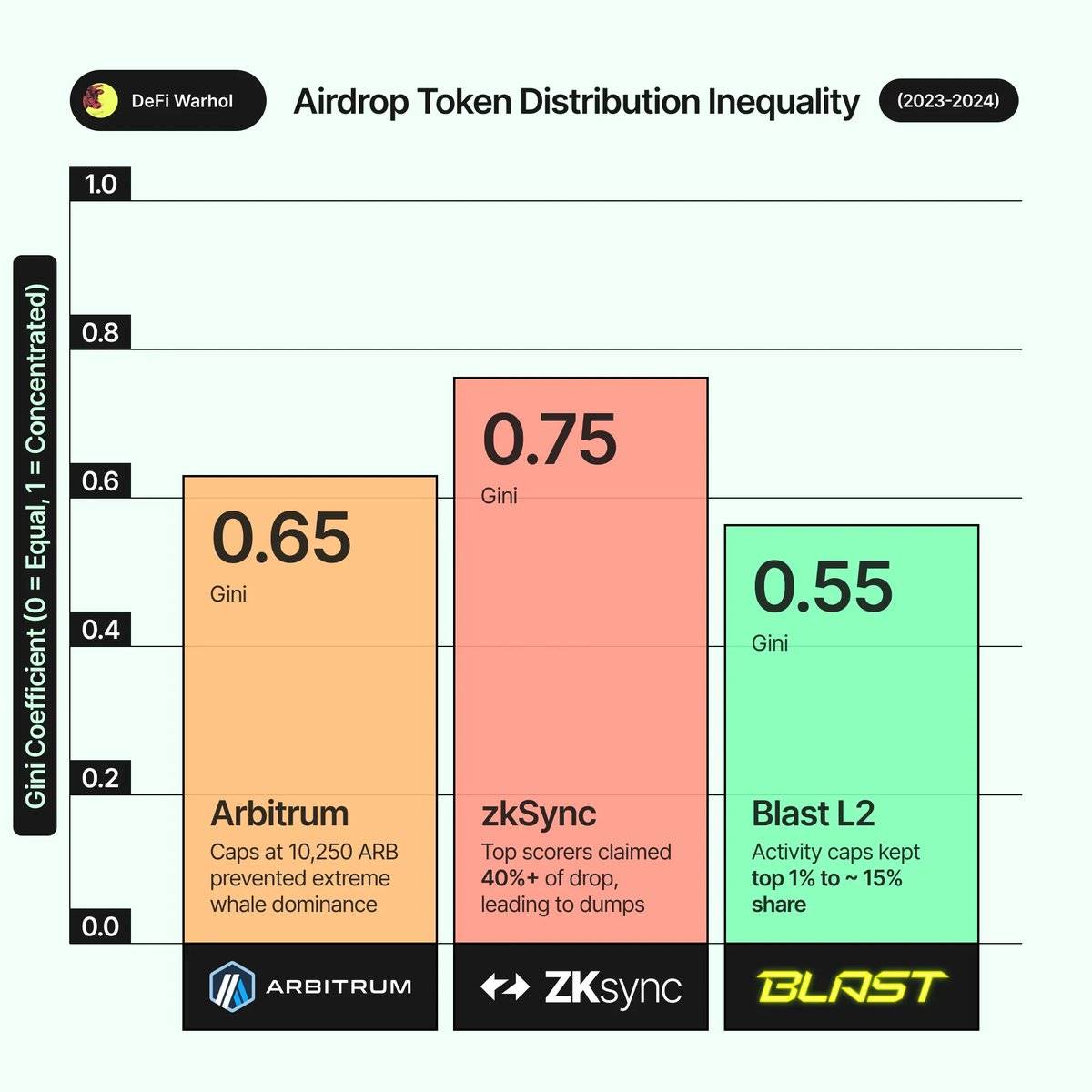
In summary, larger community allocations, higher token liquidity, and reasonable valuations typically indicate healthier airdrops. In contrast, those with minimal allocations or severe lock-ups, along with inflated valuations, usually fall into the "mine, withdraw, sell" category. If participation is possible, such airdrops may be suitable for short-term arbitrage but generally do not warrant significant upfront effort.
Eligibility Criteria and Sybil Attack Prevention
Next, we need to closely examine how to meet the eligibility criteria for the airdrop and how the project prevents Sybil attacks (i.e., multiple account "farmers"). This helps assess the actual probability of receiving allocations and whether profits can be expanded through multiple wallets (or are limited to a single wallet).
Transparency of Eligibility Criteria
How transparent is the team about the airdrop eligibility?
Some airdrops are "retrospective" based on historical behavior and come with unexpected criteria (for example, Uniswap's airdrop surprised everyone by giving 400 $UNI to all users who had ever used Uniswap). Other airdrops are task- or points-based, such as Optimism, Arbitrum, and many testnet tasks.
If the airdrop criteria are public (or at least can be inferred from documentation or leaked information), I will list these criteria and assess their difficulty. For example, Arbitrum's airdrop clearly outlined an action-based points system (such as cross-chain funding, trading in different months, deploying liquidity, etc.).
This transparency allows me to plan ahead and achieve the highest points in my wallet. Conversely, if the criteria are vague, you may need to "cast a wide net" by participating in various activities to ensure eligibility, which is not only inefficient but can also waste time and resources.
Investment-to-Reward Ratio for Each Wallet
Assess the potential rewards for eligible wallets.
Sometimes the team hints at reward tiers, or this can be inferred from similar historical airdrops. For example, many Ethereum Layer 2 (L2) airdrops ultimately brought ordinary user wallets tokens worth $500 to $2,000. If I expect this airdrop's range to be similar and the tasks to be relatively simple, it is definitely worth participating. However, if it requires a very high investment (like running a node for months) but only yields similar rewards, I might only operate one wallet or even forgo participation altogether. On the other hand, if there is a possibility of receiving five-figure rewards (like early dYdX traders who received tens of thousands of dollars in $DYDX airdrops), then a higher investment is justified.
Additionally, I will consider whether using multiple wallets can significantly enhance returns or if the rules might limit such actions. Many airdrops explicitly attempt to prevent Sybil attacks (multiple account abuse). For instance, Optimism identified and excluded over 17,000 Sybil addresses (about 6.8% of eligible wallets) in its 2022 airdrop; Hop Protocol even reclaimed tokens claimed by Sybil addresses after the airdrop.
If a project strongly opposes Sybil attacks, using dozens of wallets may backfire, as you could waste gas fees and ultimately be disqualified.
My principle is: if the risk of Sybil is high, focus on one or a few high-quality wallets (with real activity) rather than spreading investments too thin.
Sybil Resistance Mechanisms
In addition to direct bans, I also look for mechanisms that favor real users through point weighting or standard design.
Some projects reward hard-to-fake behaviors more highly (such as long-term activity, on-chain reputation NFTs, or KYC). LayerZero marked 800,000 addresses as Sybil addresses in 2024 and planned to reduce their rewards to 15% of normal levels.
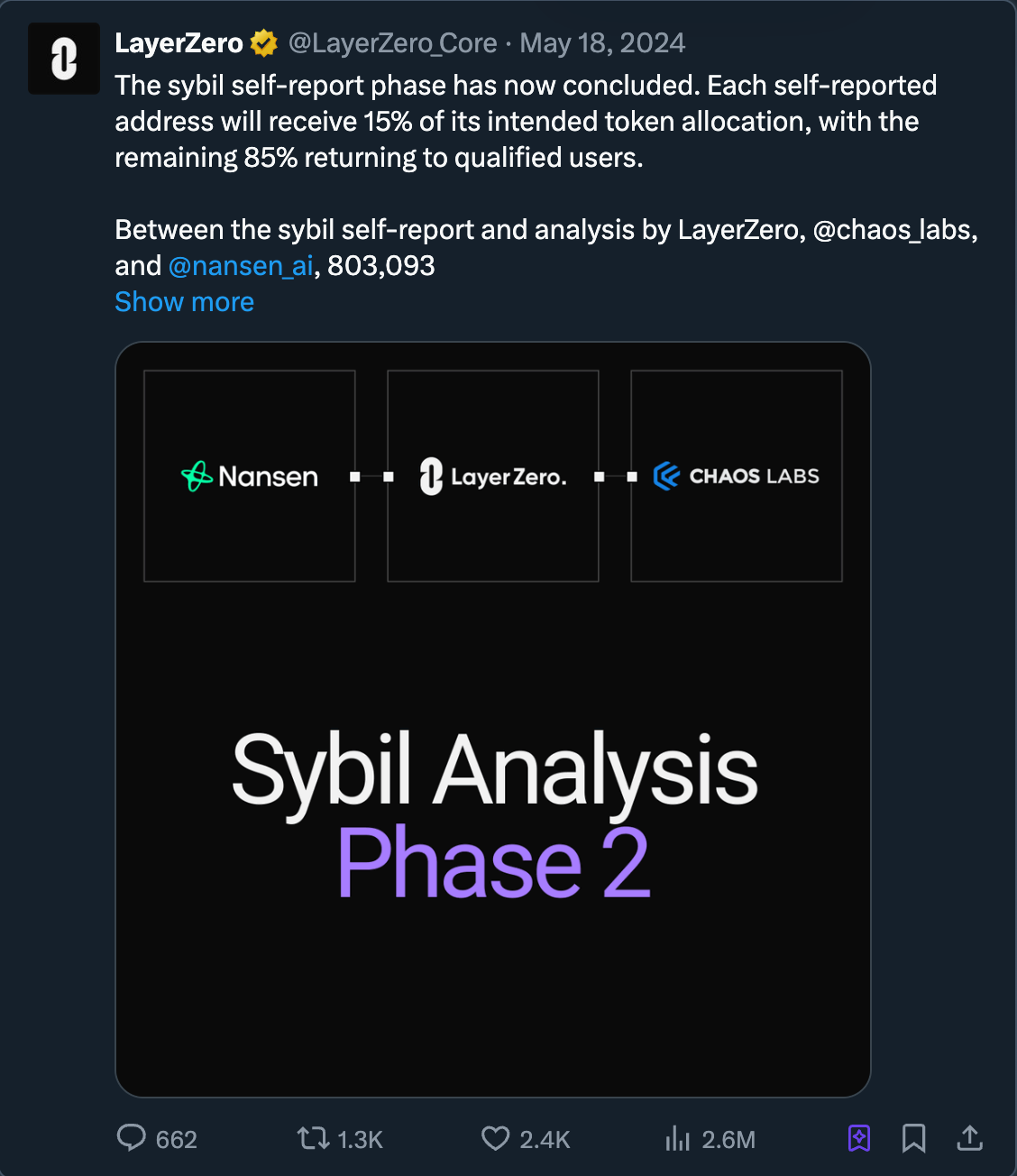
Starknet's first airdrop required holding at least 0.005 ETH on L2 at the time of the snapshot, which seems like a small requirement but excluded many real users who did not retain funds on L2. I will consider these special conditions: if I find unusual criteria (such as minimum balances, specific NFTs, etc.), I will adjust my "airdrop mining" strategy, such as ensuring that all participating addresses meet the balance requirements before the snapshot.
Furthermore, if a project has previously issued testnet NFTs or held Crew3/Galxe events, these may become prerequisites for the airdrop; missing early tasks could completely disqualify you, so I will closely monitor these activities.
Risk of Rule Changes
The worst-case scenario is that you complete all the requirements but are disqualified due to rule changes. While this situation is relatively rare, some projects do adjust their criteria at the last minute to combat Sybil attacks or respond to community feedback. Sometimes users believe they meet the criteria but are ultimately excluded, leading to dissatisfaction and backlash. Staying active in the project's community is very helpful. I have seen some protocols hint at what behaviors they consider illegitimate (for example, funding dozens of new wallets from the same address = being banned).
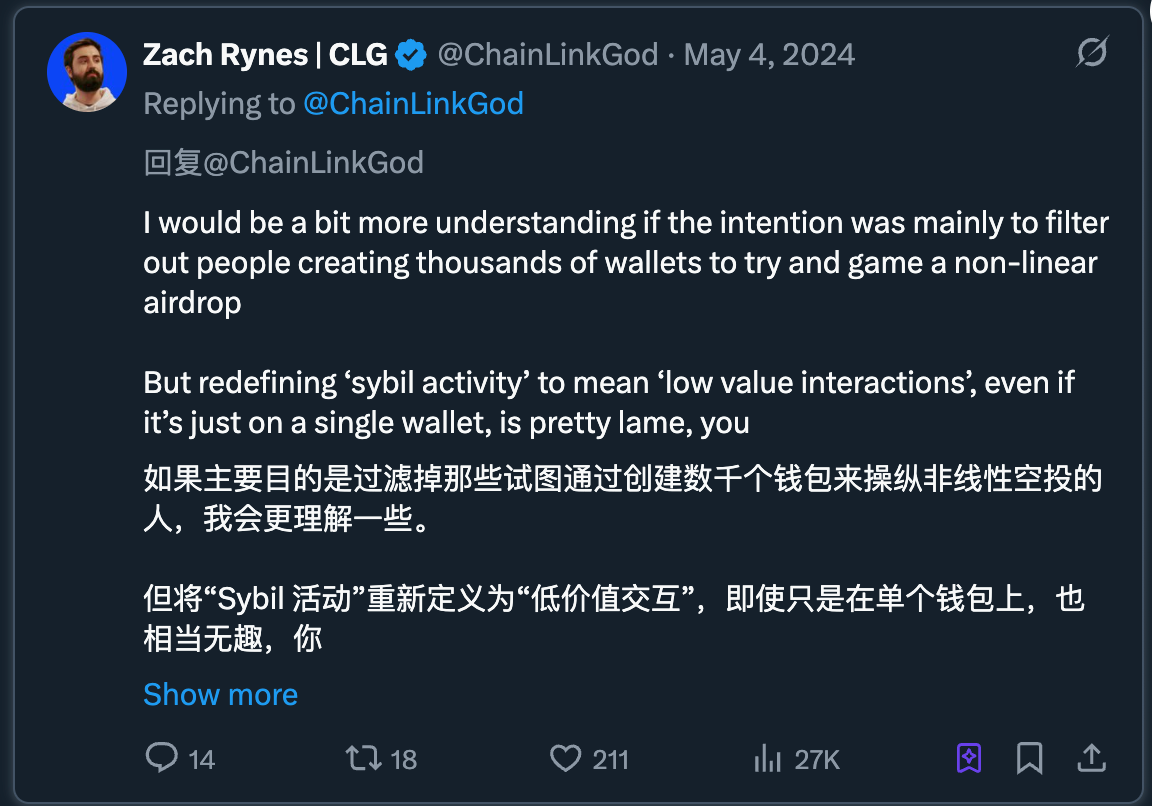
I appreciate projects that can communicate clearly, but we always assume that the possibility of being excluded is not zero. This mindset can help avoid overconfidence. A key point to remember is: "If you miss the airdrop, it's your fault, no excuses." On-chain data does not care about any reasons, so I will try to conduct "airdrop mining" in a way that appears natural under scrutiny.
The core point is: understanding the eligibility rules can help us gauge the competitiveness of the airdrop and what strategy to adopt. If it is a high Sybil risk scenario, more caution is needed (it is more worthwhile to invest time in a reliable identity); whereas in completely open scenarios (no Sybil checks, purely based on transaction volume, etc.), a broader multi-wallet strategy may be feasible, but in such cases, returns are often diluted by a large number of "airdrop farmers." This is a delicate balance, and my default strategy is to at least present as a "real core user" on one account, allowing me to pass most Sybil screenings and receive substantial rewards.
Investment, Costs, and Risk vs. Reward
"Airdrop mining" is essentially an investment of time and funds, so I must conduct a cost-benefit analysis in advance:
Time and Complexity
Some airdrops only require a one-time action (for example, making a trade on a decentralized exchange (DEX)). Others, like testnet programs, may require weeks of running software, completing tasks, or months of regular use. I will plan these requirements. If the task list includes dozens of operations (such as cross-chain bridging, trading, or providing liquidity on multiple dApps), I will estimate the total time investment.
Spending 100 hours for a potential return of $500 is clearly a poor return on investment (ROI). Rather than that, I would prefer to invest my time in more valuable opportunities. I am particularly wary of "points" activities that do not have a clear end date; these activities can turn into endless "treadmills" with diminishing returns.
My experience participating in some L2 incentive programs in 2022 taught me to set an exit standard. For example: "If after a month my points do not reach at least X% of the top users, I will reassess and possibly exit."

Gas and Direct Costs
I will calculate the gas (transaction fees) and other related costs (such as cross-chain bridge fees, minimum deposit requirements, etc.) that need to be incurred. For instance, Arbitrum's airdrop criteria encourage users to bridge over $10,000 and trade over several months, but if network gas fees are high, these operations may not be cheap. All these expenses need to be weighed against potential returns.
A good practice is to simulate a few operations first, observe the gas consumed, and then multiply by the number of iterations or wallets. I have abandoned some "airdrop mining" plans that seemed promising narratively because their gas costs could exceed the expected rewards (especially during the high gas fee periods of 2021, where many smaller airdrops weren't even worth the $100 claim fee).
Capital Risk
Do you need to lock up a large amount of capital or bear market risks? Providing liquidity, lending funds, or staking may expose you to impermanent loss or even smart contract risks. For example, during the "yield farming" summer in DeFi, some liquidity mining projects (like Sushi, etc.) brought airdrops, but farmers had to face the risks of impermanent loss or protocol vulnerabilities.
If you must deposit a large amount of funds into an emerging protocol (like a new cross-chain bridge or lending dApp) to meet the airdrop conditions, you need to assess whether the smart contract has been audited and consider the risk of potential hacking. This risk is not hypothetical; from the $600 million cross-chain bridge exploit on Ronin to failures of some smaller testnet cross-chain bridges, I have seen some "airdrop farmers" lose their principal in systems with vulnerabilities while chasing airdrops.
Worst-Case Scenario Assessment
Always ask yourself one question: "What if I end up with nothing?"
If the answer is that I wasted time or money beyond my means, then it’s not worth it. I assume a certain percentage of "airdrop mining" will end in failure (for example, the project cancels the airdrop, I get filtered out, or the token becomes worthless). For instance, I spent a lot of time on some L1 testnets (which I won't name here), but these projects never launched tokens, resulting in a total sunk cost. These failures taught me to minimize irreversible costs.
For time, this means setting regular checkpoints to reassess (don’t be blinded by the sunk cost fallacy). For money, this means not spending excessively on gas or maintaining flexibility (for example, using scripts or choosing off-peak times to reduce costs).
To decide "if it's worth it," I often perform a quick expected ROI calculation: for example, the probability of the airdrop occurring (assuming an 80% chance it will happen, 20% chance it will be canceled) * estimated token value (like $1,000 per wallet) minus costs. If the final expected value is clearly positive and there are no qualitative issues, I will proceed. If the result is close to zero or negative, I will abandon it or wait for more clear information.
Market Environment and Timing
Bull Market vs. Bear Market
In a bull market, airdrops can yield extremely high returns. Tokens typically launch at higher valuations, and buyer FOMO (fear of missing out) is stronger. In a bear market, even decent projects may face tepid market demand. For example, many major airdrops during 2022-2023 (like Optimism, Aptos, etc.) occurred in a bear market environment, leading to significant drops in token prices post-launch and slow price recoveries.
In contrast, airdrops during the 2021 bull market cycle often saw token prices rise after launch. I do not attempt to perfectly predict macro market trends (airdrop mining itself is relatively neutral before token launches), but the market environment will influence my exit strategy (discussed later) and my level of engagement in mining. During the frenzy of a bull market, I might mine more opportunities and hold tokens for a longer time; whereas in a bear market slump, I will focus on the most promising projects and plan to sell quickly when tokens launch.
Narrative Cycle
I mentioned narrative matching in fundamental analysis, but timing is equally important. Is a particular narrative in an upward phase or has it become overcrowded?
For example, the restaking narrative was very hot in early 2024, and any whispers of an airdrop would generate massive attention. If you participated early (like providing restaked ETH when TVL was low), you would stand out more; but by the first quarter of 2024, later participants had entered a highly competitive pool.
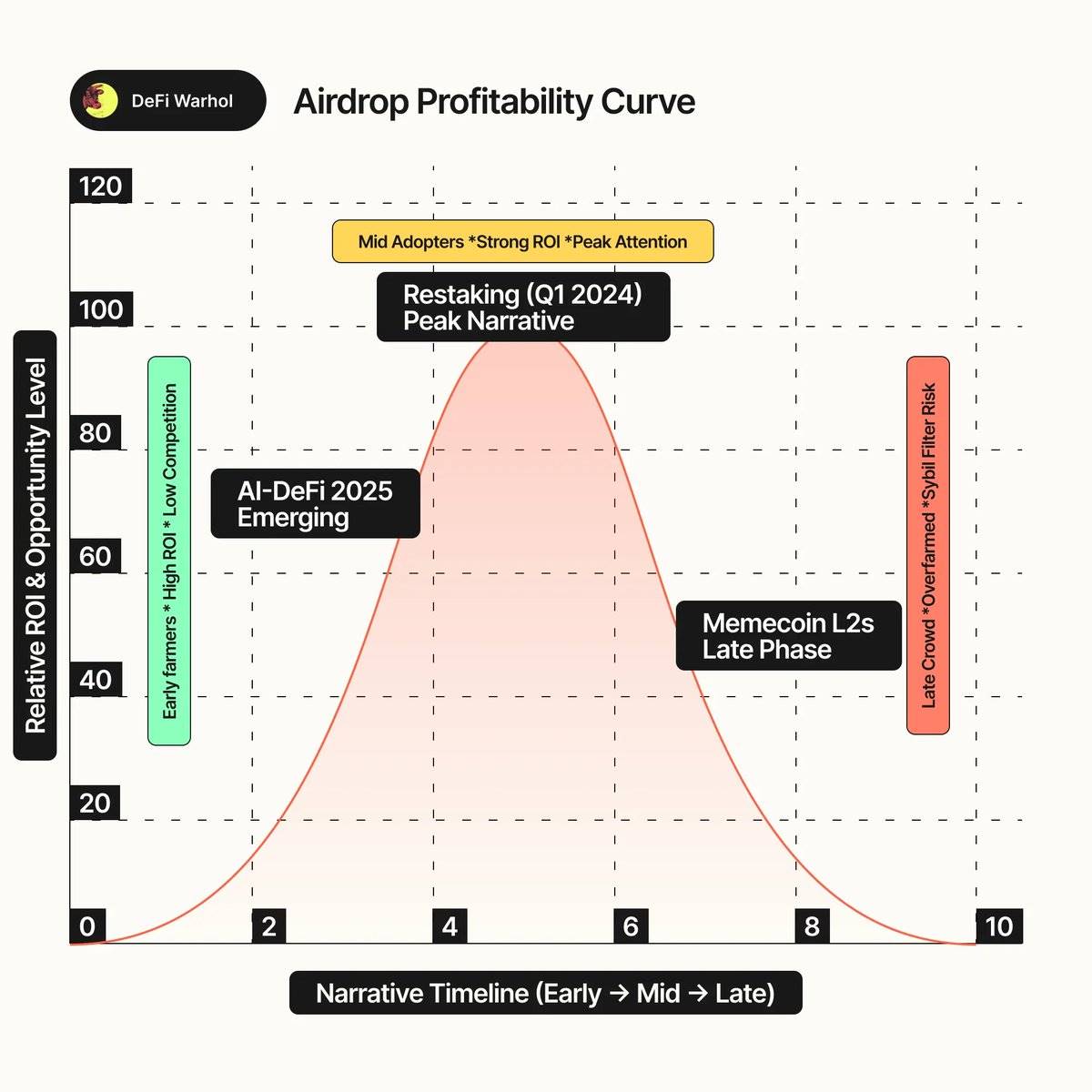
I will try to determine whether an airdrop's "meta-narrative" is in the "early stage" or "late stage." If the entire crypto Twitter (CT) is discussing a particular testnet's mining, it is likely that the easy money-making opportunities have passed, or the backlash against Sybil attacks will be very strong. Conversely, an activity that is relatively low-key in an emerging field may be a hidden gem. For example, in 2025, as mixed AI and DeFi protocols began to gain attention, airdrops in this area may not yet have been flooded by miners, thus providing a higher probability of success.
Project's Own Timeline
Consider the project's progress on its roadmap. If the mainnet or token release is imminent (like within a few weeks), then your mining time is very limited, and the airdrop criteria may already be set.
If the project is a testnet without a clear end date, you need to judge how long you can continue mining. Some projects operate in "incentive seasons," and if the incentive program's timeline is public, understanding this information will be helpful. Pay special attention to snapshot times: many airdrops will snapshot user activity at a certain block height. If you learn or suspect that a snapshot is coming soon, this is the last chance to ensure your activities meet the criteria (or if you think you have done enough, you can choose to stop investing to avoid overspending).
How the Project Responds to News and Setbacks
This point is relatively subtle, but we can gauge a project's potential by observing how it responds to adverse events or updates. Does a testnet crash scare away users, or do they return? Did the team delay the token sale? For example, if a project suffers a hack or exploit, and the team can respond professionally while the community remains supportive, this resilience actually boosts my confidence (indicating the project has the capability to handle crises). On the other hand, if a minor delay causes a mass exodus from Discord, it may indicate that the project's attention is too superficial.
Projects that can "ignore bad news in a bull market narrative" (even when issues arise, their community remains optimistic) often find themselves in a stronger position. I have seen similar situations in the Arbitrum and Optimism projects; despite some controversies and governance-related FUD (fear, uncertainty, and doubt) during airdrop distributions, the user base continued to grow, indicating that the underlying demand was real.
In summary, context is important. During periods of market overheating (when everyone is mining frantically and competition is fierce), my strategy will be more cautious; whereas in a market downturn (when few are willing to invest), I will be more aggressive, as the eventual returns may be higher relative to the investment. For example, my largest airdrop gains came from mining activities at the end of 2022, when many were disappointed with the market; by the time these tokens (like Arbitrum) launched in 2023, I was one of the few recipients and successfully capitalized on the market frenzy.
Liquidity and Exit Strategy
Finally, I plan how to realize value if the airdrop actually arrives. An old trading adage is: "Plan the trade, execute the plan." For airdrops, this means:
Claiming Strategy
When airdrop tokens are open for claiming, the market often experiences extreme volatility. I remember the day Arbitrum opened claims; claimants paid high gas fees, and the RPC servers crashed, creating chaos.
To prepare for this situation, I will set up backup RPC nodes in advance, and if possible, write scripts to automate claims and be ready the moment the tokens launch. If I have multiple wallets, I usually prioritize those accounts that I plan to sell immediately (to complete transactions before the peak); whereas if some small wallets' tokens are intended for long-term holding, I don’t mind claiming them a bit later.
Additionally, I need to check if there is a deadline for claiming; many airdrops may allow several months for claims, but some projects will reclaim unclaimed tokens to the DAO (Decentralized Autonomous Organization) after a period. However, for me, there usually won’t be an issue of not claiming, as I will actively claim the tokens.
Market Liquidity
I prefer to choose airdrops that will list on well-known exchanges or have deep AMM (Automated Market Maker) liquidity from day one. If the project has large investors backing it or is generating significant market interest, mainstream exchanges like Binance or Coinbase are likely to list these tokens (or at least establish deep liquidity pools on major decentralized exchanges (DEX)).
For example, Arbitrum's $ARB was almost immediately tradable on major trading platforms after launch, with trading volume quickly surpassing $1 billion, providing a relatively easy exit. In contrast, lesser-known airdrops may only trade on a single DEX with low liquidity; selling a large amount of tokens at once could lead to significant price drops, or slippage could erode profits. Therefore, I will conduct research in advance: if the team announces market maker partnerships or exchange support, this is a positive signal; conversely, if it’s a niche Cosmos airdrop requiring token swaps through a native wallet, I will expect significant price volatility and adjust my position size (or even abandon it if a smooth exit cannot be guaranteed).
Sell, Hold, or Stake
I will decide in advance the ratio of selling to holding tokens. Based on experience, most airdrop tokens will peak in price within the first two weeks after launch.
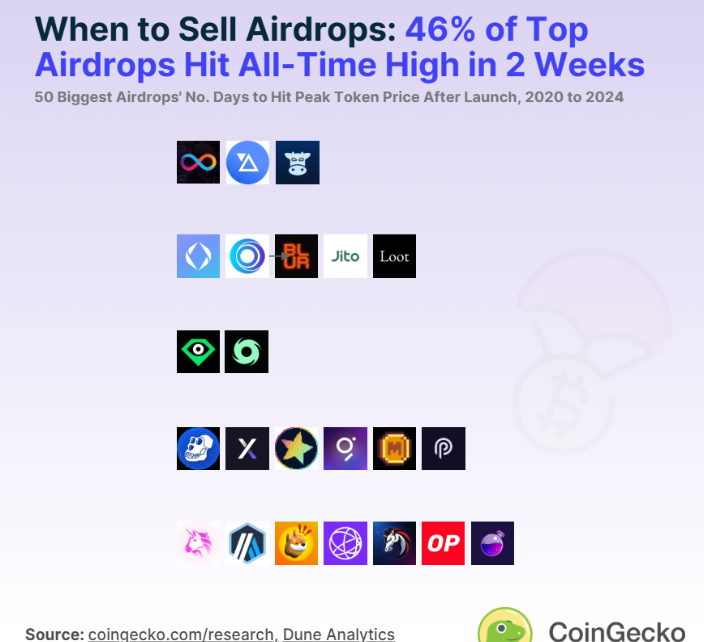
I tend to sell a large portion of tokens early; typically, my strategy is to sell about 50% on the first day of the airdrop token launch or immediately after claiming to lock in profits, then hold the remaining portion and set trailing stop losses or target prices. This approach hedges against the common "dumping" risk of token prices while also retaining some upside potential if the token rises against the trend.
I will only choose to hold a large portion of tokens long-term in very rare cases (for example, if I have strong confidence in a project, or if the token launch price is significantly below my fundamental expectations). Even then, if I can earn additional returns through staking or lending, I will consider utilizing these tokens, but I will remain cautious: if the yield requires a lock-up mechanism (like governance lock-up), I will weigh the flexibility lost as a result.
Tax and Legal Considerations
I cannot completely ignore the impact of regulatory aspects. In many jurisdictions, airdrops are often considered taxable income (at least based on the value at the time of receipt). I will take this into account, as a large airdrop could trigger a significant tax bill.
Sometimes, selling immediately is a wiser choice to reserve for taxes. Additionally, I need to be aware of regional restrictions. For example, EigenLayer prohibits U.S. users from claiming airdrops. I will closely monitor whether the project requires KYC (Know Your Customer) or implements geographic restrictions. If so, this airdrop may be essentially worthless to me, or I may need to participate through an entity established in a more favorable region. This situation is becoming an emerging issue. For instance, some airdrops in 2025 have begun requiring simple KYC to comply with regulatory requirements.
Essentially, airdrop tokens only count as real gains once they are monetized. I will formulate a clear exit plan for each airdrop to avoid ultimately becoming the "bag holder" of rapidly depreciating tokens.
Best Practices and Final Thoughts
In summary, here are some best practices I follow when evaluating whether early airdrops are worth investing in:
Do Your Homework
Before participating in any "tasks," research the project's fundamentals and token plans. If possible, read the project documentation or governance forums to look for clues about the token. Many missed opportunities often stem from the assumption that there will be an airdrop when, in reality, there may not be one (and vice versa). Do not rely solely on rumors; be sure to verify the authenticity of the information.
Formulate Hypotheses (But Validate)
Form a clear rationale explaining why this airdrop might be valuable, such as "this project is leading in an emerging field and may launch a token with a low initial market cap but high demand." Then, continuously validate this hypothesis through on-chain data and news. If the project's narrative logic collapses (for example, if growth stagnates or competitors surpass it), be prepared to adjust your strategy or abandon "farming." Flexibility is a virtue; stubbornly clinging to a failed hypothesis will only waste months. In my experience, arrogance and confirmation bias are the biggest enemies. Never assume you "deserve" an airdrop; adjust based on the developments in reality.
Scoring and Comparison
You can score each opportunity through multiple dimensions (such as fundamentals, tokenomics, investment costs, etc.). I sometimes use spreadsheets to assign weights to each factor (for example, protocol quality 30%, reward potential 30%, cost/risk 20%, difficulty of preventing Sybil attacks 20%). This quantitative approach allows me to confront the shortcomings of projects directly. For instance, a project may be very popular, but if the token distribution mechanism is poor, the overall score may decrease. By scoring, you may find that a less popular airdrop offers a better risk/reward ratio than those hot projects with 100,000 competitors.
Risk Management, Don't Gamble
Treat airdrop "farming" as a portfolio. Diversify your investments across several promising opportunities rather than going all-in on one project. This way, even if one project fails (no airdrop or token price slump), other projects can compensate for the losses. I usually run 5-10 "farms" simultaneously within a quarter, knowing that only about half may yield returns. Always remember to protect your capital: "When the super airdrop happens, you need to be there." This means not spending all your ETH on gas fees for some marginal airdrops. Keep enough reserve funds to go all-in when a truly significant opportunity arises.
Pay Attention to On-Chain Signals
Closely monitor the on-chain dynamics of the project, such as new wallet growth, testnet usage data, or (if public) leaderboard rankings. If you notice your ranking declining while "farming" (as others invest more), reassess whether it’s worth continuing. Similarly, if you find the project's activity declining, it may indicate that the community has lost interest—this is a bad signal for the token's ultimate value.
Plan Your Exit (and Entry)
Enter "farming" with a results-oriented mindset. Be clear about how to claim the airdrop and what your selling strategy is before you start. Try to avoid falling into a liquidity trap. If the airdrop implies long-term lock-ups or trading only on a specific chain's decentralized exchange (DEX), you need to decide in advance whether you can accept this situation. If not, you might even skip this project altogether, as you may not be able to exit gracefully. When the airdrop arrives, strictly execute your plan; do not let greed or fear dictate your decisions. I have seen people receive airdrops worth $10,000 but choose to hold on, hoping it will rise to $20,000, only to watch it drop to $2,000. Don’t be that person. Systematically lock in profits. After all, it’s not every day that someone gives you tokens "for free"; cashing in on victories in a timely manner is not shameful.
Learn and Iterate
Every airdrop, whether successful or not, brings lessons. Develop a habit of recording, or at least mentally noting what you did right or wrong. Did you overestimate a project's potential? Did you overlook key eligibility requirements? Or did you have a hunch about an airdrop's potential but didn’t invest enough effort (that feeling of "I knew it, but I still didn’t do enough")? We have all experienced these situations. Use these experiences to optimize your framework.
After years of practice, my attitude towards airdrops has become more cautious yet opportunistic—skeptical of hype but decisive when discovering undervalued opportunities. The goal is to cultivate a keen intuition to identify advantages: the scenario where "the market undervalues this airdrop's worth, and I can profit from it."
Evaluating an early airdrop is both an art and a science. The art lies in understanding human motivations and crypto narratives, while the science involves analyzing data and tokenomics. The best airdrops often reward deep early engagement rather than just fleeting interactions.
This means that if you genuinely use and support quality projects early on, you will typically reap the richest rewards. My framework aims to help filter out such opportunities. By focusing on fundamentals, maintaining a realistic attitude towards token design, carefully assessing the relationship between investment and return, and flexibly adjusting strategies based on new information, I have significantly increased the success rate of only "farming" those truly worthwhile airdrops.
Ultimately, airdrop hunting should be treated like any other investment: it requires thorough due diligence, risk management, and a clear strategy. By doing so, you can find real opportunities amid the noise of information and hope to seize the next airdrop opportunity on the scale of UNI or ARB when it comes knocking.
免责声明:本文章仅代表作者个人观点,不代表本平台的立场和观点。本文章仅供信息分享,不构成对任何人的任何投资建议。用户与作者之间的任何争议,与本平台无关。如网页中刊载的文章或图片涉及侵权,请提供相关的权利证明和身份证明发送邮件到support@aicoin.com,本平台相关工作人员将会进行核查。




